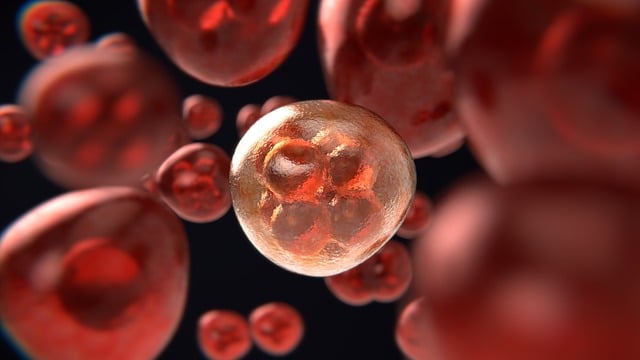Orthopedic stem cell therapy leverages the regenerative power of stem cells from bone marrow or fat tissue to treat musculoskeletal disorders, offering a promising alternative to surgery for conditions like arthritis and tendon injuries. Types of stem cells, including mesenchymal stem cells (MSCs) and induced pluripotent stem cells (iPSCs), can differentiate into specialized cells to repair cartilage, bones, and soft tissues. Ongoing research aims to optimize these therapies, making them safer and more effective while exploring patient-specific treatments for global musculoskeletal care improvement.
Orthopedic stem cell therapy is transforming the landscape of joint care, offering innovative solutions for repairing and regenerating damaged tissues. This article delves into the exciting world of stem cells, exploring their fundamental role in unlocking orthopedic potential. We examine various types of stem cells, their unique advantages, and extensive applications in joint repair. Additionally, we highlight ongoing research, painting a promising picture of future prospects in this groundbreaking field.
Understanding Stem Cells: Unlocking Orthopedic Potential
Stem cells hold immense potential in the field of orthopedic medicine, offering a promising avenue for treating and potentially reversing various musculoskeletal disorders. These unique cells have the remarkable ability to regenerate and differentiate into different types of tissues, making them a game-changer in orthopedics. Orthopedic stem cell therapy leverages this natural process to repair damaged bones, cartilage, and soft tissues, which is particularly beneficial for conditions such as arthritis, tendon injuries, and spinal cord damage.
Understanding the basic biology of stem cells is crucial to unlocking their orthopedic potential. Stem cells can be derived from various sources, including bone marrow, adipose tissue (fat), and umbilical cord blood. Each type has its advantages, with some demonstrating greater potency and versatility in terms of differentiation capabilities. Researchers are continually exploring these options, aiming to develop effective treatments for a wide range of orthopedic conditions, ultimately improving patient outcomes and quality of life.
Types of Stem Cells Used in Orthopedic Treatments
Orthopedic stem cell therapy leverages the power of various types of stem cells to treat and regenerate damaged musculoskeletal tissues. The most commonly used include mesenchymal stem cells (MSCs), which are harvested from bone marrow, adipose tissue, or umbilical cord blood. MSCs are prized for their ability to differentiate into multiple cell types relevant to orthopedic health, such as chondrocytes, osteoblasts, and tenocytes, making them versatile tools in repairing cartilage damage, enhancing bone regeneration, and treating tendon and ligament injuries.
Another type gaining attention is induced pluripotent stem cells (iPSCs), which are adult cells reprogrammed to behave like embryonic stem cells. iPSCs offer the advantage of patient-specific customization, reducing the risk of immune rejection. They can be derived from a variety of sources, including skin cells or blood cells, making them a potentially abundant and accessible resource for orthopedic applications. Ongoing research continues to explore the therapeutic potential of these and other stem cell types, aiming to revolutionize orthopedic treatments by harnessing the body’s inherent regenerative capabilities.
Advantages and Applications in Joint Repair
Stem cells offer a promising avenue for orthopedic treatments, especially in joint repair and regeneration. One of the primary advantages is their ability to differentiate into various types of specialized cells required for tissue repair, such as chondrocytes for cartilage restoration or osteoblasts for bone formation. This multi-potentiality makes them invaluable for addressing a range of orthopedic conditions, from articular cartilage damage to osteoporosis and traumatic injuries.
The applications of orthopedic stem cell therapy are diverse. In joint repair procedures, these cells can be used to engineer new, functional tissue, promoting healing and potentially reducing the need for invasive surgeries or artificial implants. They also hold potential in tendon and ligament regeneration, as well as in treating bone fractures by enhancing bone marrow-derived cell activity. This innovative approach promises to revolutionize orthopedic care, offering patients more effective, natural solutions for joint health and functionality.
Future Prospects and Ongoing Research in Orthopedic Stem Cell Therapy
The future of orthopedic care looks promising with ongoing research into stem cell therapy as a game-changer in treating musculoskeletal disorders. Scientists and medical professionals are continually exploring the potential of various types of stem cells, such as mesenchymal stem cells (MSCs), to regenerate damaged tissues and promote healing. In terms of orthopedic applications, MSCs have shown remarkable capabilities in regenerating bone, cartilage, and tendon, offering hope for advanced treatments for conditions like osteoarthritis and traumatic injuries.
Ongoing research focuses on enhancing the efficacy and safety of stem cell therapy, including developing novel delivery methods and optimizing stimulation strategies. The goal is to harness the self-renewal and differentiation potential of these cells to create personalized therapies tailored to individual patients’ needs. With continued advancements, orthopedic stem cell therapy has the potential to revolutionize the way we treat musculoskeletal conditions, providing long-lasting relief and improved quality of life for patients worldwide.
Orthopedic stem cell therapy represents a promising frontier in joint repair and regeneration, offering advantages such as natural tissue restoration and potential for long-term solutions. As research progresses, we can expect to see further refinements in stem cell types, application techniques, and therapeutic outcomes. This innovative approach holds great promise for improving quality of life for patients suffering from orthopedic conditions, paving the way for a future where damaged joints can heal and regain their full function.
